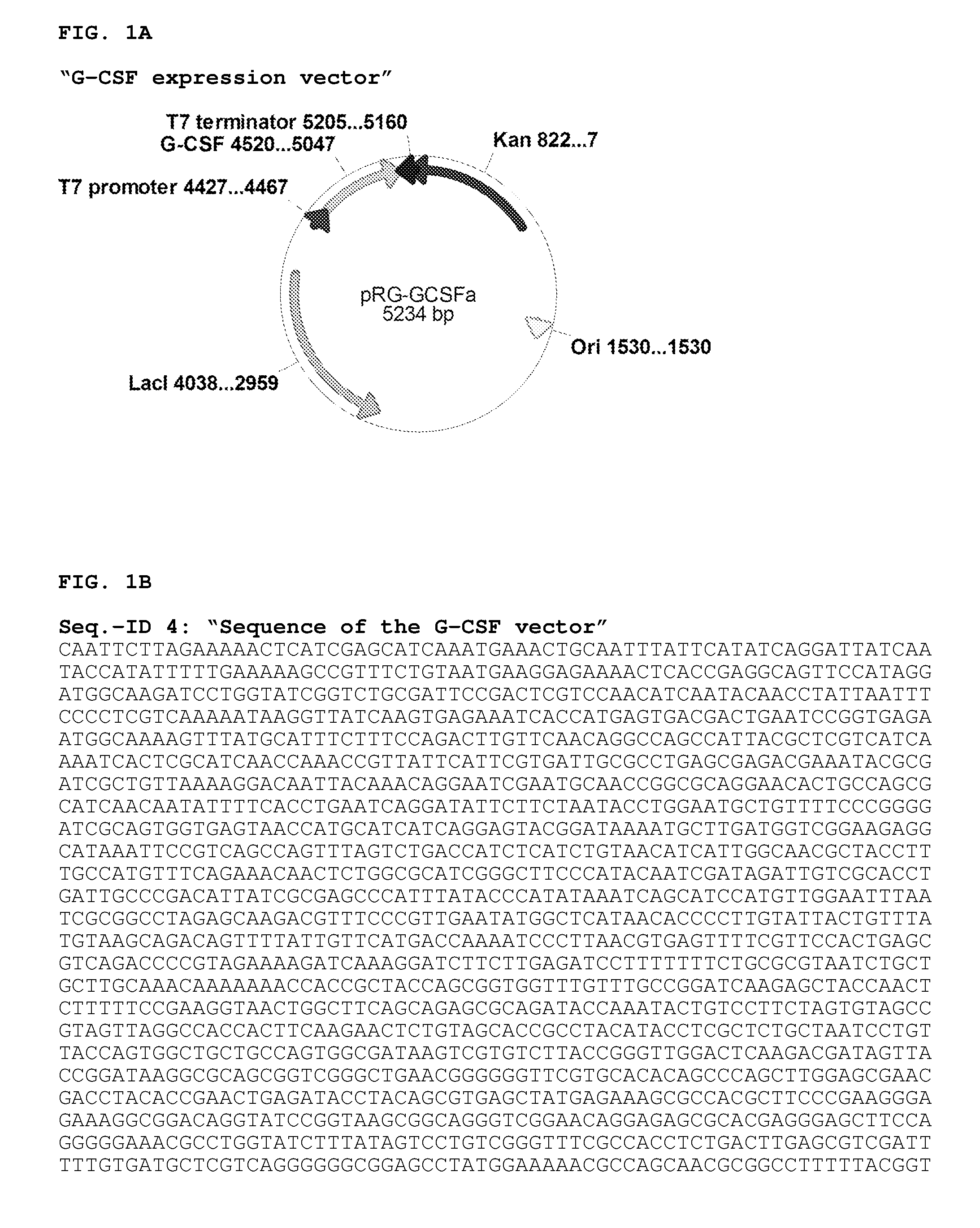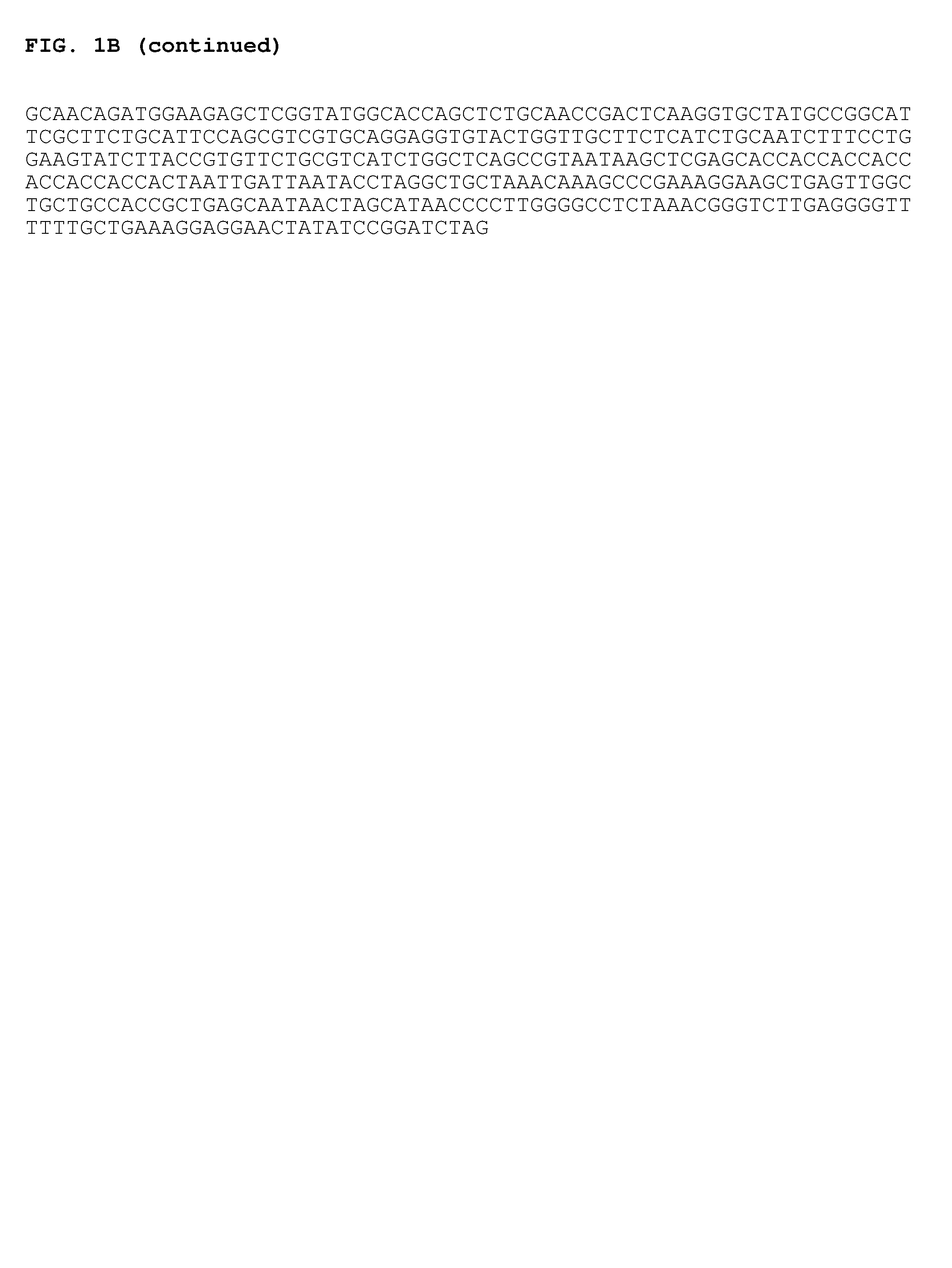Method for the production of polypeptides
a polypeptide and polypeptide technology, applied in the field of polypeptide production, can solve the problems of inability to obtain difficulty in obtaining the polypeptide of interest in soluble and active form, and inability to meet the requirements of the inclusion body, so as to improve the yield of recombinant polypeptide, and improve the yield of active protein
- Summary
- Abstract
- Description
- Claims
- Application Information
AI Technical Summary
Benefits of technology
Problems solved by technology
Method used
Image
Examples
example 1
Production of G-CSF
Material and Methods
1. Generation of a Host Cell Line
Preparation of T7 RNA Polymerase Cassette
[0126]In order to isolate the 4.44 kb gene cassette containing the functional T7 RNA polymerase (Accession number AY264774, protein AAP33914.1] operably linked to the regulatory domains of the lac operon, the genomic DNA from the Escherichia coli BL21(DE3) strain (Novagene) was used. The DNA was prepared with the Quiagen Genomic tip-20 kit (Quiagen, Hilden, Germany) using a standard protocol. The T7 cassette was then amplified by PCR reaction. The amplification was carried out in a 100 μl reaction volume utilizing the KOD HiFi DNA Polymerase (Merck, Darmstadt, Germany). The reaction mixture contained DNA polymerase buffer, 5U KOD HiFi DNA polymerase, 2 mM MgCl2, 250 μM dNTPs, 100 ng DNA template, 10 μM forward primer (IntLambd 1), 10 μM backward primer (IntLambd 2). For the reaction a PCR cycler [MJ Research PTC-200] was used with the following settings: Denaturation at 9...
example 2
Fermentation and Expression
[0147]The G-CSF (filgrastim) was produced with the recombinant E. coli C2523 T7 pol pRG / GCSFa clone (E. coli transformed with an expression vector comprising G-CSF). Under aseptic conditions the prepared seed culture media was inoculated with 0.10-0.15 cm3 cell suspensions obtained from a thawed working cell bank vial that was stored in liquid nitrogen. The inoculated seed culture flasks were incubated in a gyratory shaker incubator at 37° C. at 185 rpm for 24-28 hours. When the mean value of the optical density at 600 nm (OD) of the six shaked flask culture reached 0.9-1.1, the content of the flask was collected into a sterile 5 dm3 glass flask equipped with a silicone tube. The collected 3 dm3 volume seed culture was transferred with a WM323U / R pump to the 100 dm3 fermenter filled up to 75 dm3 with sterile and supplemented production medium (GBA, synthetic medium with glycerol as carbon source). The cultivation was performed under strict aerobic conditio...
example 3
Harvest of Bacteria
[0148]Agitation, aeration and feeding of carbon sources were stopped, the culture was cooled below 15° C., and the bacteria were harvested by separation at 11000 g. The cells sedimented in the rotor and were washed out (discharged) by water. The bacterial cell concentrate was collected, diluted back to its half volume with water, and 0.5M NaH2PO4 was added to a final concentration of 10mM. The total mass of the wet bacterial cells (biomass) were about 10-11.5 kg.
PUM
| Property | Measurement | Unit |
|---|---|---|
| optical density | aaaaa | aaaaa |
| temperature | aaaaa | aaaaa |
| temperature | aaaaa | aaaaa |
Abstract
Description
Claims
Application Information
 Login to View More
Login to View More - R&D
- Intellectual Property
- Life Sciences
- Materials
- Tech Scout
- Unparalleled Data Quality
- Higher Quality Content
- 60% Fewer Hallucinations
Browse by: Latest US Patents, China's latest patents, Technical Efficacy Thesaurus, Application Domain, Technology Topic, Popular Technical Reports.
© 2025 PatSnap. All rights reserved.Legal|Privacy policy|Modern Slavery Act Transparency Statement|Sitemap|About US| Contact US: help@patsnap.com



